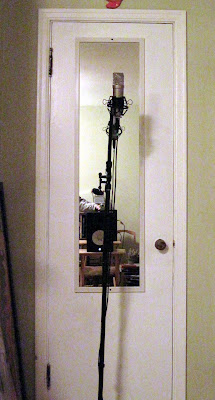I had recorded a poem or two for a friend of mine (Robert Knapp) the other day and the conclusive best of the lot was one called "Verse Zont". It was cut up type of reading if I recall correctly. I had ran across a musical piece by Alvin Lucier from 1969 called "I am Sitting in a Room" (the original recording can be found here on ubu.com's site). I decided to take the poem and run it through a Lucier inspired recording machine. I copied the instructions for the piece below. Instead of electromagnetic tape, I used computers with 44.1k-16 bit audio with MOTU 828 mk 1 and Lexicon Lambda audio interfaces. I used a Yamaha HS-10 monitor for playback and a Rode NT1A for recording. The room chosen was my living room (see pic above). I choose 8 as the number of times at first, but I ended up doing 10 cause it was fun.
As this is is an indeterminate piece, I will note some entertaining facts about my particular session. Date was April 14 2011 around nightfall. There was a Kansas thunderstorm moving in and you can hear thunder and recursive thunder through out. My cats was also like "WTF" the entire time and there are a few cat reactions to the experiment on the recording. I varied the volume between takes. The posted version is a edited level matched version.
I AM SITTING IN A ROOM (1969)
Alvin Lucier (b. 1931)
for voice and electromagnetic tape.
Necessary Equipment:
1 microphone 2 tape recorders amplifier 1 loudspeaker
Choose a room the musical qualities of which you would like to evoke.
Attach the microphone to the input of tape recorder #1.
To the output of tape recorder #2 attach the amplifier and loudspeaker.
Use the following text or any other text of any length:
"I am sitting in a room different from the one you are in now. I am recording the sound of my speaking voice and I am going to play it back into the room again and again until the resonant frequencies of the room reinforce themselves so that any sem- blance of my speech, with perhaps the exception of rhythm, is destroyed. What you will hear, then, are the natural resonant frequencies of the room articulated by speech. I regard this activity not so much as a demonstration of a physi- cal fact, but more as a way to smooth out any irregularities my speech might have."
Record your voice on tape through the microphone attached to tape re- corder #1.
Rewind the tape to its beginning, transfer it to tape recorder #2, play it back into the room through the loudspeaker and record a second genera- tion of the original recorded statement through the microphone attached to tape recorder #1.
Rewind the second generation to its beginning and splice it onto the end of the original recorded statement on tape recorder #2.
Play the second generation only back into the room through the loud speakerand record a third generation of the original recorded statement through the microphone attached to tape recorder #1.
Continue this process through many generations.
All the generations spliced together in chronological order make a composition the length of which is determined by the length of original statement and the number of generations recorded.
-The versions in which one recorded statement is recycled through many rooms.
-Make versions using one or more speakers of different languages and in different rooms.
-Make versions in which, for each generation, the microphone is moved to different parts of the -room or rooms.
-Make versions that can be performed in real time.
http://www.ubu.com/sound/lucier.html
Alvin Lucier (b. 1931)
for voice and electromagnetic tape.
Necessary Equipment:
1 microphone 2 tape recorders amplifier 1 loudspeaker
Choose a room the musical qualities of which you would like to evoke.
Attach the microphone to the input of tape recorder #1.
To the output of tape recorder #2 attach the amplifier and loudspeaker.
Use the following text or any other text of any length:
"I am sitting in a room different from the one you are in now. I am recording the sound of my speaking voice and I am going to play it back into the room again and again until the resonant frequencies of the room reinforce themselves so that any sem- blance of my speech, with perhaps the exception of rhythm, is destroyed. What you will hear, then, are the natural resonant frequencies of the room articulated by speech. I regard this activity not so much as a demonstration of a physi- cal fact, but more as a way to smooth out any irregularities my speech might have."
Record your voice on tape through the microphone attached to tape re- corder #1.
Rewind the tape to its beginning, transfer it to tape recorder #2, play it back into the room through the loudspeaker and record a second genera- tion of the original recorded statement through the microphone attached to tape recorder #1.
Rewind the second generation to its beginning and splice it onto the end of the original recorded statement on tape recorder #2.
Play the second generation only back into the room through the loud speakerand record a third generation of the original recorded statement through the microphone attached to tape recorder #1.
Continue this process through many generations.
All the generations spliced together in chronological order make a composition the length of which is determined by the length of original statement and the number of generations recorded.
-The versions in which one recorded statement is recycled through many rooms.
-Make versions using one or more speakers of different languages and in different rooms.
-Make versions in which, for each generation, the microphone is moved to different parts of the -room or rooms.
-Make versions that can be performed in real time.
http://www.ubu.com/sound/lucier.html

No comments:
Post a Comment